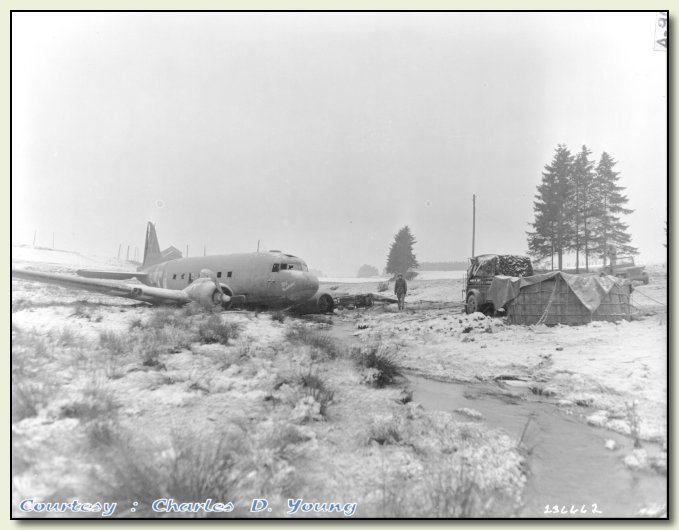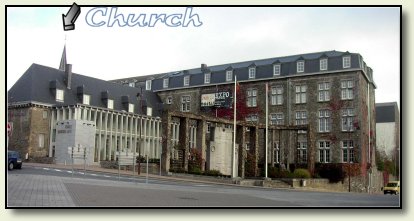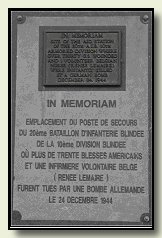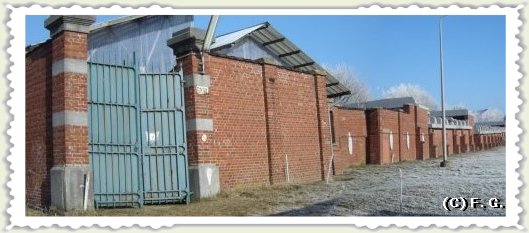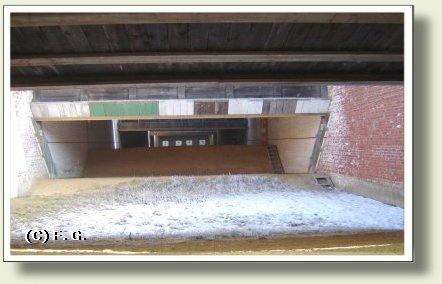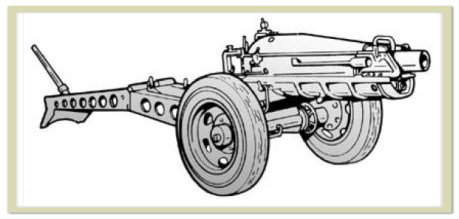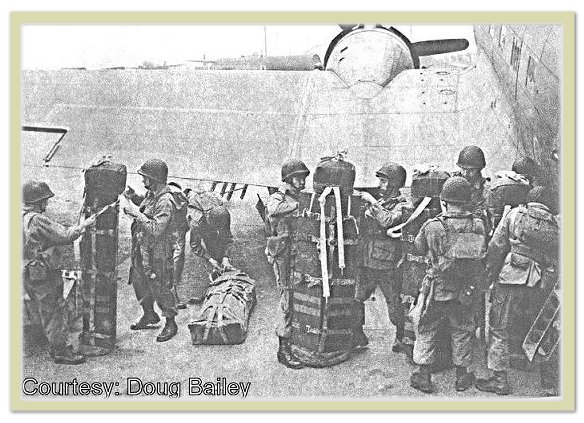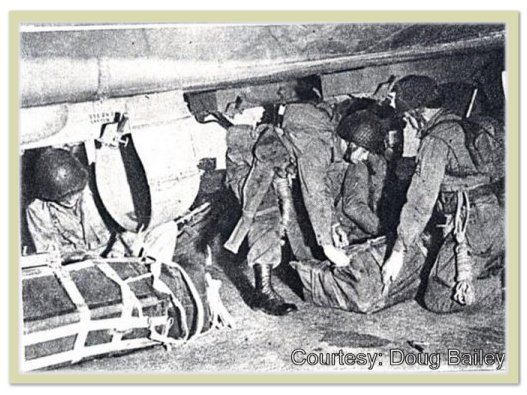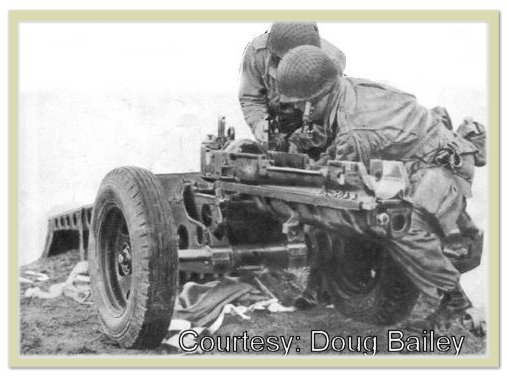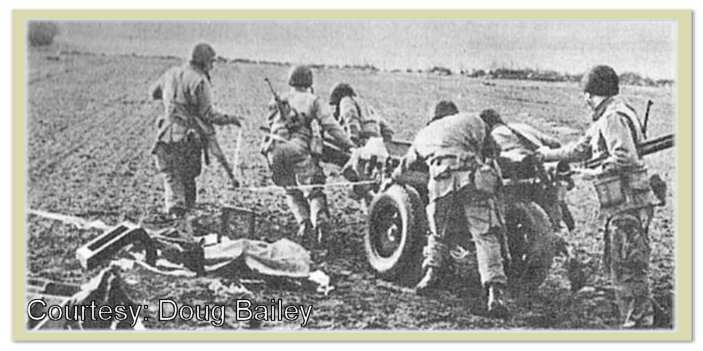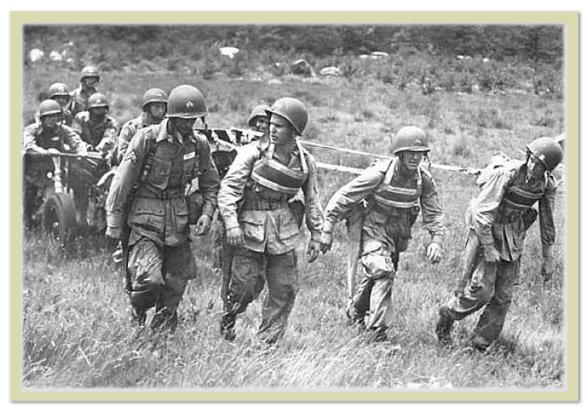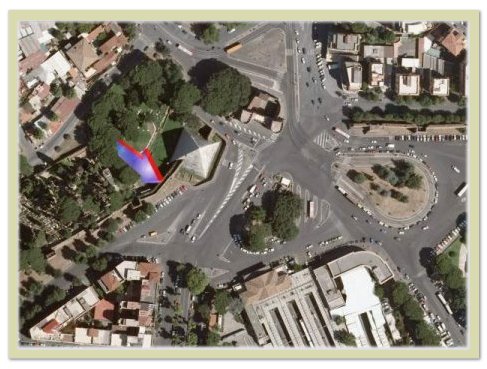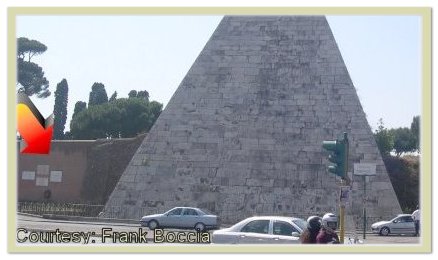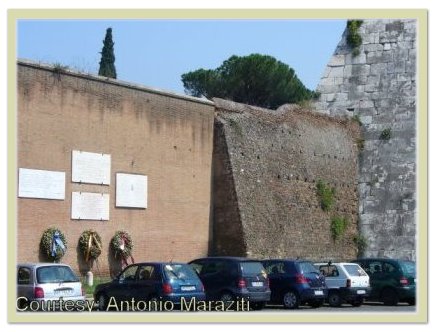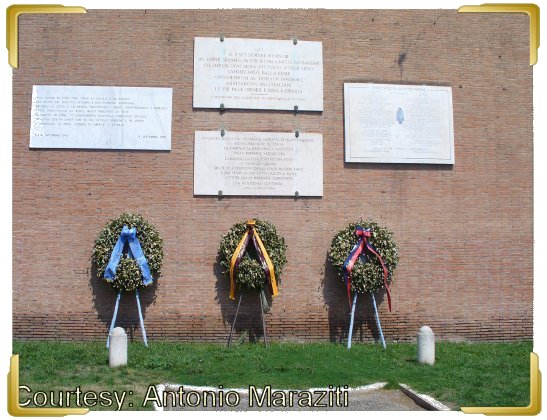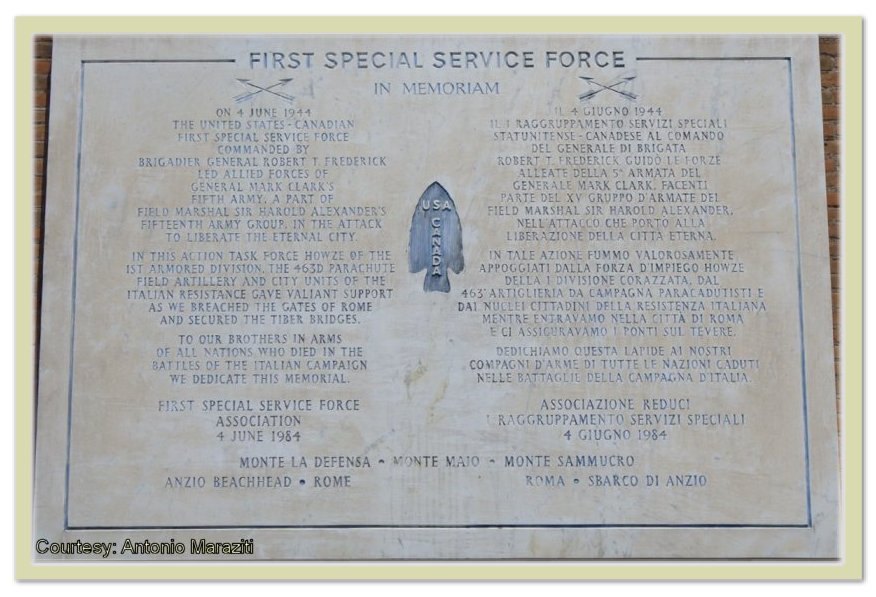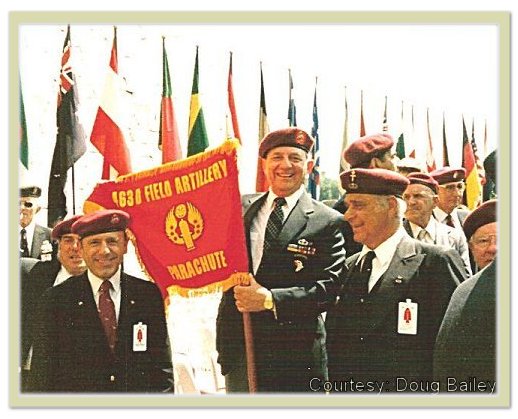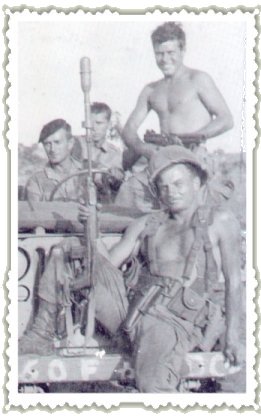|
Frequently asked questions
Question about a crashed C47 airplane at Savy
When I was visiting Bastogne together with Don Burgett and Mark Bando, Mark showed us the crash site of the C47 airplane 'Ain't Missbehavin' at Savy along the road from Hemroulle towards the Heintz Barracks (HQ General McAuliffe). My thoughts were immediately with the crew, what happened to them ? I found this picture on the internet (click on it to go to the site where we found it...).
Thanks to Tony Coulter from Philly and Randy Hills
(www.440thtroopcarriergroup.org) I got in contact with Mr. Charles Young
and could ask him about the crew.
Charles's answer :
Filip, Ain't Missbehavin' was the aircraft of flown by Capt. Ernest Turner, and he flew it on this mission when he was shot down. We published a close-up photo of three crew members standing on the other side of this aircraft on page 363 of the book my father and I did, Into The Valley. We published the photo you sent a link to on the following page. Both photos were originally in my father's collection. Crew: Capt. Ernie Turner, pilot; Lt. Keistutis J. (Casey) Narbutas, co-pilot; S/Sgt. Richard G. Whitehurst, radio operator (in the photo) and S/Sgt. John E. Douglas, crew chief. They had some bumps and bruises, and Sgt. Douglas was shot in the leg, but all survived. The Website URL is www.usaaftroopcarrier.com.
Before that I asked Ken Hesler (D/463) about this too :
Filip, I can confirm the photograph, the best one I have seen. Your are correct on the road and ditch (note: positions of Baker Btry I visited with Ken. Filip). One can read the name, "Ain't Missbehavin" clearly. The trailer and tarp covered ammo boxes to the right are those of D Btry. If you back off from the photo at about a 30-degree angle for a short distance, you would be at the D Btry gun positions. Good going!
Question about the 101st Airborne Aid Station at Bastogne
To Doug Bailey :
When you were hurt on Christmas day, after being in the chapel at Hemroulle, were you transferred to an Aid Station in Bastogne, or moved out directly out of town on the 26th when general Patton's 4th Armored Division broke through at Assenois ? I heard the 10th Armoured Aid Station in the centre of Bastogne (in a Sarma food store, in the Rue de Neufchateau) got a hit on Christmas Night with fire bombs, and half of the wounded in there were burned alive. Also the Belgian nurse Renée Lemaire got killed in that German attack. Since the Germans captured the Airborne Hospital between Champs and Sprimont a week earlier, I wondered if the 101st managed to have some Aid Station in town just as the 10th Armored did ?
Doug's answer :
Filip, After the 4th Armored got to us we went by Ambulance to the 106th Evacuation Hospital in Thionville, France. Then to Paris on a Hospital Train and then by C-47 to the 106th General Hospital close to the city of Bourmouth in Southern England. Regards,
Additional information from local Bastogne guide Henri Mignon :
The 101st had an Aid Station in a school with the name "Le Petit Séminaire",
situated in front of the Bastogne Church in the town centre. The 501st Parachute
Infantry had its HQ in the same school. The Aid Station was in a little church
inside of the school.
The wounded were also taken care of at the 101st Airborne (General McAuliffe)
HQ, Here are some pictures of this shelter :
Question : How did one load the 75mm Pack Howitzer and drop it ?
Courtesy 1. Douglas - Doug - Bailey (WWII veteran 463PFA) Courtesy 2. Article ‘Field Artillery’, July-August 2000, “Cannons under Canopy”, by Major Scott T. Glass, QM.
American airborne Field Artillery units in World War II primarily employed the M1A1 75-mm pack howitzer on an M8 carriage. Initially designed in the 1920s as a weapon for disassembly into loads carried by mules, it delivered a 14-pound (6.35 kg) shell to a maximum range of 9,610 yards (8787 meter).
The artillery community later developed the M8 carriage specifically for airdrop operations. The gun weighed 1,339 pounds (607 kg), and during the opening phases of airborne operations, the gun crews wheeled it by hand without a prime mover as standard practice. Indeed, the doctrinal manual for airborne Field Artillery at the time recognized crew muscle as the prime means of moving guns on the airborne battlefield.
The 75-mm howitzer’s relatively small size and weight allowed disassembly into nine paracrate or parapack loads containing gun components and ammunition.
The 75-mm howitzer’s relatively small size and weight allowed disassembly into nine paracrate or parapack loads containing gun components and ammunition. The versionshown here is the M1A1 on the M1 (M116) carriage
1. Front Trail Section and Drawbar 2. Axle, Rear Trail Section and Toolbox 3. Sleigh and Gun Cradle 4. Top Gun Cradle 5. Cannon Tube
6. Breechblock and Sights 7. Carriage Wheels 8. 10 Ready Rounds of Ammunition
9. Paracaisson Handcart of Eight Additional Rounds
Gun crews packed loads One through Five and Nine and attached them to fuselage and wing racks of C-47 transport aircraft. The jumpmaster released the bundles over the drop zone (DZ) by toggling a series of switches. As he did so, gunners pushed out a bundle from the troop door containing 75-mm howitzer loads Six, Seven and Eight roped together and then followed the bundle out. A daisy chain harness connected the loads jettisoned from outside the aircraft and ensured they arrived on the DZ close together. The M1A1 had few peers at the time as an airborne indirect fire weapon, and the British airborne forces used it instead of attempting to develop a similar weapon.
Doug: the 75mm Pack Howitzer could be taken apart to be loaded on the C47. Six parapacks loaded under the C47 and a Door load of the wheels and a padded box holding the Gun sight and the Breechblock.
Airborne gunners prepare parapacks next to their C-47
transport.
Doug : the Equipment Chute was loaded into the Pod in front, the Pod for the equipment Chute was under the center (body) of the C-47 and each of the 6 parapacks had their own Chute, also the Door load had it's own Chute. The 6 Parapacks were attached to the fuselage (underneath the body of the of the plane). Nothing was attached under the Wings.
Doug : If you found all the pieces of the Gun you would assemble them. In the Picture the Recoil system is installed and the Breech Block is in and the rear Trail is attached and the Tube or Barrel has to be added, Top Sleigh would be on top.
Some of the Plywood Paracrates held the ammunition and after you took the ammunition out they contained a Handle that you could pull out and also a axle with two wheels, then you would put the Ammunition back in and you could pull the Paracrate with the Ammunition.
Doug : After you assembled the Gun and since we were not dropping any Jeeps we had to move it by Hand. The door load consisted of the two wheels and a padded box that held the Breechblock and sight : sometimes we would attach a Daisy chain to all the bundles so if any bundles got hung up the weight of the others would pull it free to drop.
The Pilot or co-pilot could make the Bundles drop and there was a handle by the Door you could pull to release the Belly loads. we would usually have a piece of pipe or a round piece of wood to put under the door load to make it easier to push out the Door. Also they had little colored lights attached to the loads that activated when the equipment Chute opened, it would pull a piece of cardboard out and the light would go on.
1943 photo showing a pack howitzer crew moving the gun with a system on harnesses. These harness assemblies went in the paracrates and were dropped with the gun.
Doug, what about finding the different parts of the canon after landing ? Was it difficult ?
Filip, to find and assemble the gun depends on the area it landed. Some gun crews never even found there Gun if it landed in a gully or thick brush. In the Sicily drop I never found my Gun and crew until daylight probably because the plane I was in just carried Ammunition 75mm and Bazooka ammunition.
In the France jump I landed in a road in the middle of lots of Trees and Brush and it was also daylight when Carl Noline who was a Apache Indian from the San Carlos Indian Reservation in Arizona and I found our 4th Gun Section. We were the last two of the stick that jumped from our plane.
Question : Where is the FSSF marble plaque in Rome located ?
The Official History on the site states : "With its new designation, the battalion remained in support of the FSSF which, in early June 1944, led the Allied Forces into Rome. A marble plaque in that city commemorates the FSSF accomplishment, noting the assistance of “the armored units of Task Force Howze, 463rd Parachute Field Artillery Battalion, and the Italian Resistance…”
The location of the plaque is in Rome, on a wall by St. Paul's Gate (Porta San Paolo), left of the Pyramid dedicated to Caio Cestio, located at the Ostiense Square (Piazzale Ostiense). On the picture below is an aerial view of the wall and pyramid.
These are some pictures of the area, wall and plaque.
Beneath the text on the plaque mentioning the 463rd PFA
Commemoration in 1984: Doug Bailey : I took this picture of the 463rd guys at the Ceremonies they had for the 1st Special Service Force and the 463rd members at St. Paul's Gate where the Plaque is on the Wall. My Wife and I went over with a bunch of 1st Special Force and 463rd guys in 1984.
Doug Bailey (also Ken Hesler and Cynthia Baker) : From Left to right :
Close to Flag is Tony Spagnol, holding Flag is Jay Karp (B Btry).
Question: what were the markings on the 463PFA vehicles ?
Johan Willaert : I don't have a picture of 463PFA vehicles in WW2. I presume the markings were not the same during the whole war either, but I found a picture of the 460PFA in Southern France, at the same timeframe of the 463rd being there. The marking is not completely visible but it's likely 460F, so the conclusion might be that a correct marking will be 463F
|
